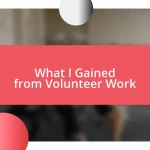Key takeaways:
- Helping others not only alleviates their burdens but also enriches our own emotional well-being and sense of community.
- Recognizing opportunities to assist involves being attentive to signs of distress and proactively offering specific support tailored to individual needs.
- Building trust and rapport is essential; simple gestures, consistent follow-ups, and open conversations foster deeper connections and reinforce support.

Understanding the Importance of Helping
Helping others isn’t just a matter of altruism; it profoundly impacts both the giver and the receiver. I still remember the day I came across a stranger struggling with a heavy bag on a crowded street. Something so simple as offering assistance not only lightened their load but also filled my heart with warmth. Isn’t it fascinating how acts of kindness ripple through our lives?
Research shows that helping can significantly enhance our own well-being. I’ve found that whenever I take the time to support someone in need, whether it’s through volunteering or just lending an ear, I feel more connected to my community. Have you ever noticed how good it feels to uplift someone else? This emotional exchange often leads to a deeper sense of purpose in our own lives.
Moreover, helping fosters a sense of belonging. I think about the friendships and bonds I’ve formed through shared experiences of helping others. Each story creates a thread that weaves us closer together. What if everyone made one small effort to help? Just imagine the sense of unity we could build!

Recognizing Opportunities to Help
Recognizing opportunities to help often requires us to be aware of our surroundings and attentive to the emotions of those around us. I remember a day in a café when I saw a distressed mother juggling her infant and a spilled coffee. Instinctively, I stood up and offered her a hand, helping to clean up and chatting with her to ease her stress. Those small, fleeting moments can lead to meaningful connections, igniting a warmth that reminds us of our shared humanity.
Here are some signs that someone could use a helping hand:
– Visible Stress: A person who appears overwhelmed, whether through body language or facial expressions.
– Social Withdrawal: Someone who isolates themselves or avoids interactions may need an invitation to engage.
– Change in Routine: If a friend suddenly stops participating in activities they once enjoyed, it could signify deeper struggles.
– Direct Requests: Sometimes, people will explicitly ask for help, and it’s essential to respond without hesitation.
– Observing Small Struggles: Even simple tasks, like carrying groceries or holding doors, can signal an opportunity to lend support.
In my experience, these moments can create a ripple effect, encouraging others to open up or share their burdens, creating a supportive community.

Choosing the Right Approach
Choosing the right approach when helping someone is crucial to ensuring that our assistance is genuine and impactful. I’ve learned that sometimes, a gentle touch or a soft spoken word can be more valuable than a grand gesture. For example, I once stepped into a situation where a friend was visibly distressed over personal issues. Rather than offering unsolicited advice, I simply sat with them in silence at first, letting them know they were not alone. It was that quiet acknowledgment that revealed the most important need in that moment—connection.
Another approach I often consider is tailoring my response to the specific needs of the individual. I recall a time when a co-worker faced overwhelming stress from a project. Instead of just saying, “Let me know if you need help,” I proactively asked if I could assist with a particular task. This made them feel supported in a tangible way, rather than leaving them to navigate their struggles alone. It’s a reminder that intention matters, and how we choose to engage with others can make all the difference.
Lastly, I find that being present is key in choosing the right approach. When I helped a neighbor who was feeling isolated during a challenging time, I just showed up with a cup of tea and sat down to chat. The simple act of being there communicated my support far more effectively than any elaborate plan. It’s often the little, heartfelt gestures that speak volumes.
| Approach | Description |
|---|---|
| Gentle acknowledgment | Simply being present and allowing the person to express themselves can foster connection. |
| Proactive support | Offering specific assistance rather than waiting for a request can show genuine care. |
| Being present | Simple gestures, like sharing a cup of tea, can mean more than grand efforts. |

Establishing Trust and Rapport
Establishing trust and rapport is essential when helping someone in need. I remember volunteering at a local shelter, where I encountered a guest who seemed hesitant to open up. After several days of simply sharing meals and small talk, they finally confided in me, mentioning that my consistent presence made them feel safe. It’s fascinating how simply being there, day after day, can lay the foundation for trust.
In my experience, showing authenticity makes a significant difference. Imagine being on the receiving end—wouldn’t you prefer someone who genuinely listens rather than one who just offers superficial comfort? I always strive to share a bit about my own challenges during these moments. It breaks down walls and invites the other person to share their own struggles. I remember sharing my experience with anxiety while helping a friend through a tough time, and it seemed to encourage them to open up about their feelings, creating a genuine bond between us.
When we build rapport, it often leads to deeper connections. Sometimes, I ask open-ended questions like, “What’s been weighing on your mind lately?” This invites a conversation rather than a simple reply. One evening, during a casual chat, I asked this question to a fellow volunteer. What started as a light conversation blossomed into a heartfelt discussion about their dreams and fears. That’s the magic—creating a safe space where someone feels comfortable to express themselves.

Providing Practical Support Solutions
When it comes to providing practical support solutions, I’ve found that sometimes the simplest actions can be the most effective. Not long ago, a friend faced unexpected financial difficulties. Instead of just expressing sympathy, I offered to help them create a budget plan. It surprised me how a little bit of organization and clarity around their expenses made a substantial difference in their stress levels. Have you ever noticed how a little structure can lead to a sense of control in chaotic moments?
Another instance that stands out to me was when I volunteered to help a family in need move into a new home. They were overwhelmed, and so were the kids. I took it upon myself to organize a small group of friends for a moving day. Not only did we lift heavy boxes, but we also made it a fun day with music and snacks. The sheer joy on their faces reminded me that practical support goes beyond just physical help—it’s about creating an environment where people can feel momentarily relieved and even uplifted.
Lastly, I believe that information can also be a powerful tool. One time, a neighbor mentioned they were struggling to navigate health services for their elderly parent. I took some time to research options and compiled a list of resources for them. The gratitude they expressed made me realize that sometimes knowledge is the best way we can assist others. It’s a gentle reminder that when we share what we know, we empower others to take the next steps in their journey. Have you ever thought about how sharing knowledge can be just as impactful as offering direct aid?

Following Up and Staying Connected
Staying connected with someone I’ve helped is vital in showing that my support doesn’t stop after the initial act. I recall checking in with a coworker who had recently lost their job. After a few weeks of sending them motivational quotes and resources, I received a heartfelt message back saying that my gestures made a tough transition feel less lonely. Isn’t it fascinating how a simple text can brighten someone’s day and prompt them to keep moving forward?
Following up also helps to reinforce the relationship we’ve started to build. For example, I once helped a neighbor with their garden after they expressed feeling overwhelmed. A few weeks later, I popped by to see how their plants were doing. It turned into a delightful afternoon, reminiscing about our progress. Moments like this remind me that genuine connections flourish when we show interest and care long after the initial help.
I’ve also learned that consistency in reaching out can lead to deeper conversations and trust. I’ve made it a habit to check in with friends who are going through challenging times. Whether it’s a text asking how their week has been or a coffee date to chat, these small efforts often lead to big breakthroughs. Have you ever thought about how a simple check-in can create a ripple effect of support and resilience in someone’s life? It truly underscores the power of staying connected.

Reflecting on the Experience
Reflecting on the experience, I realized just how transformative the act of helping can be, not only for the recipient but also for myself. I remember one instance where I offered to help a stranger carry their groceries. They were frazzled and almost in tears, struggling with the weight of both the bags and their circumstances. As we walked together, I saw that small gesture spark a connection. It made me ponder: how often do we underestimate the power of simple acts?
The emotions that surfaced during these moments were profound. After the moving day with that family, I sat back and watched their kids playing happily in their new yard. It struck me how deeply rewarding it is to witness the joy created through collective support. I couldn’t help but feel a surge of gratitude wash over me. It made me think about how deeply interwoven our lives are and how, sometimes, our small contributions can ignite someone else’s hope when they need it most.
Finally, I found that reflecting on these experiences encourages continuous learning. I’ve often asked myself what I could have done differently or better. For instance, was I truly listening to the needs of the people I helped? It’s a thought-provoking question that brings personal growth. Embracing these reflections can deepen our empathy and understanding, making our future support more effective and meaningful. Have you ever considered how reflecting on your experiences can shape not just who you are as a helper, but also who you become as a person?















